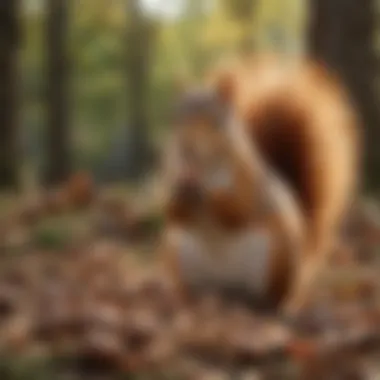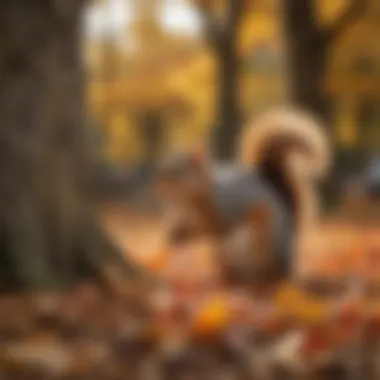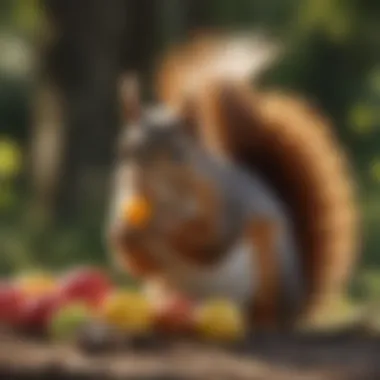Understanding Squirrel Diets: Ecological Insights Unveiled


Intro
Squirrels are often seen scurrying through the trees or foraging on the ground, yet their dietary habits are often overlooked. Recognizing the complexities of their diet is essential for understanding their role in the ecosystem and how they interact with their environment. Squirrels, belonging to the Sciuridae family, exhibit dietary preferences influenced by their species, seasonal changes, and ecological factors. Understanding these dietary habits provides a clearer picture of how these animals contribute to biodiversity and ecosystem health.
Fascinating Facts About the Animal
Unique Characteristics
Squirrels exhibit remarkable adaptability in their eating habits. They are primarily herbivorous but will consume insects and small animals when necessary. There are multiple species of squirrels, including the Eastern gray squirrel, red squirrel, and fox squirrel, each with specific dietary preferences. This diversity is largely influenced by their habitats and available food sources.
Extraordinary Abilities
Squirrels have excellent spatial memory skills, which they use to locate food sources. They can remember the locations of thousands of buried nuts and seeds. This ability not only aids in their survival but also promotes plant diversity by allowing seeds to germinate in different locations.
Prologue to Squirrel Diet
Squirrels, often seen scurrying across parks and backyards, play a significant role in our ecosystems. Their diet is not only crucial for their survival but also affects many other organisms in their habitat. This section provides insights into their eating habits, which is essential for understanding broader ecological dynamics. By exploring the components and significance of the squirrel diet, we can gain a deeper appreciation of these mammals and their functions in the environment.
Defining Squirrels
Squirrels belong to the family Sciuridae, which encompasses a variety of species, including tree squirrels, ground squirrels, and flying squirrels. They are small to medium-sized rodents characterized by long bushy tails and strong hind legs. Squirrels are primarily diurnal, meaning they are active during daylight. Their agility and dexterity allow them to navigate trees and urban environments with ease.
The diets of squirrels can vary widely among species. Tree squirrels, for instance, often consume nuts, seeds, fruits, and occasionally insects. Ground squirrels tend to have a more extensive diet that includes grasses and roots in their natural habitats. Flying squirrels, although nocturnal, share similar dietary patterns, typically favoring fruits and nuts. Thus, the dietary habits of squirrels reflect their adaptations to their specific environments.
Ecological Significance of Squirrels
Squirrels have an important role in their ecosystems. They are not just consumers; they are also significant contributors to the health of their habitats. As they forage for food, squirrels help in the process of seed dispersal. They bury nuts and seeds, some of which can grow into new plants, thus promoting biodiversity.
Moreover, squirrels are prey for a variety of predators, such as hawks, foxes, and snakes. This positions them as a crucial element in the food chain, supporting a myriad of species. Their presence in both urban and rural environments also provides a link between nature and human activity, demonstrating how wildlife and human societies can coexist.
The dietary habits of squirrels echo their broader ecological contributions, affecting plant communities and supporting myriad local wildlife.
By understanding the diet of squirrels, we can appreciate their remarkable adaptations and the vital roles they play in our ecosystems.
Types of Squirrels and Their Diets
Understanding the types of squirrels and their diets is integral to grasping their ecological roles and how they interact with their environments. Each squirrel species has developed unique dietary habits based on its habitat and lifestyle. By studying these variations, we can better appreciate their contributions to biodiversity and ecosystem health. Moreover, recognizing the specific dietary needs of each type can help in conservation efforts and urban wildlife management.
Tree Squirrels
Tree squirrels, primarily belonging to the family Sciuridae, are among the most recognizable species due to their arboreal lifestyle. This group includes species like the Eastern gray squirrel and the Fox squirrel. Their diet consists mainly of nuts, seeds, and fruits collected from trees, making them essential for seed dispersal in forest ecosystems.
Feeding Habits and Diet Composition
Tree squirrels prefer foods that are high in fat and carbohydrates, supporting their energy needs. Common foods include:
- Acorns: A significant resource, especially in the fall.
- Walnuts and Pine Nuts: These nuts provide essential oils and proteins.
- Fruits: A variety of fruits, such as berries and apples, supplement their diets.
Tree squirrels are known to exhibit caching behavior. They bury surplus food, which helps in seed distribution and promotes forest growth. However, this habit also reflects their need to store food for leaner seasons, such as winter.
Ground Squirrels
Ground squirrels differ significantly from their tree-dwelling relatives. Often found in grasslands and open areas, they belong to various genera such as Spermophilus and Otospermophilus. Their diets are varied, reflecting their diverse environments.
Feeding Preferences and Ecological Impact
Ground squirrels primarily feed on:
- Grasses and Herbaceous Plants: These make up a large part of their diet.
- Seeds: They consume many seeds from plants that grow in their habitats.
- Insects: Ground squirrels also supplement their diets with protein-rich insects.
These dietary choices are vital for maintaining the ecosystem balance. Ground squirrels help aerate and enrich the soil through their burrowing activities, while their foraging behavior helps control plant growth and pest populations.


Flying Squirrels
Flying squirrels, such as the Northern flying squirrel, are unique for their gliding ability. They inhabit wooded areas and mostly feed at night, making them nocturnal foragers. Their diet is quite distinct from both tree and ground squirrels.
Nighttime Foraging and Nutritional Sources
Their diet consists of:
- Fruits: Particularly berries, which provide sugars and water.
- Nuts and Seeds: Similar to tree squirrels but adapted for nocturnal access.
- Fungi: They consume various types of mushrooms, which are essential for their nutritional balance.
Flying squirrels play a critical role in forest ecosystems by aiding in fungal spore dispersal. These actions help maintain soil health and support forest diversity, emphasizing their importance beyond just a dietary focus.
Understanding the diets of different squirrel species is essential for comprehending their roles in our ecosystems. Each species contributes uniquely, whether through seed dispersal or soil aeration, highlighting the interconnectedness of wildlife and habitats.
Primary Foods Consumed by Squirrels
The diet of squirrels is both diverse and adaptable, reflecting the various species and their habitats. Understanding what squirrels eat is crucial to grasp how these small mammals interact with their environment. Their primary food sources play a significant role in their survival, health, and ecological impact. This section delves into the main components of a squirrel's diet: nuts and seeds, fruits and vegetables, and insects and small animals. Each of these food categories offers distinct benefits, reflecting different nutritional needs.
Nuts and Seeds
Nuts and seeds are the cornerstone of a squirrel's diet. Squirrels exhibit a strong preference for these energy-dense foods due to their high fat and protein content. Common nuts that squirrels consume include acorns, walnuts, hazelnuts, and pine nuts. These items provide essential nutrients necessary for their growth and daily activities.
Nuts and seeds also have a notable feature: they are often gathered and stored for future use. This behavior fosters a survival strategy that allows squirrels to prepare for harsher conditions, especially in winter months. The habit of hiding and forgetting stored nuts leads to seed dispersal, which contributes to forest regeneration. Thus, the act of storing nuts inadvertently aids the broader ecosystem in maintaining plant diversity.
Fruits and Vegetables
Fruits and vegetables complement the squirrel's diet throughout the year. Squirrels show preference for fruits such as apples, berries, and grapes. They also consume various vegetables, including corn and leafy greens. These fresh foods not only offer vital vitamins and minerals but also enhance their hydration.
Seasonal availability affects the consumption of fruits and vegetables. In spring and summer, squirrels have access to abundant fresh produce, allowing for a more varied diet. This variability is crucial for their health, as it helps balance the dietary intake of different nutrients, aiding digestion and boosting immunity.
Insects and Small Animals
While squirrels are primarily herbivorous, they will opportunistically consume insects and small animals. Their diet can include caterpillars, beetles, and even bird eggs, particularly when other food sources are scarce. This protein-rich food source is essential for pregnant or nursing females, as well as for growing young.
The inclusion of protein from insects provides a necessary balance to their diet. It contributes not only to physical health but also to reproductive success and development of young squirrels. Such dietary flexibility is a crucial trait that allows squirrels to thrive in various environments.
Nutritional Needs of Squirrels
Understanding the nutritional needs of squirrels is crucial for recognizing their role in the ecosystem and how variations in their diet can influence their health and survival. Squirrels, like all animals, require a balance of nutrients to thrive. Their dietary habits are not just a reflection of their preferences but are also determined by their physiological needs. These nutritional requirements can guide their foraging behaviors, as well as impact their growth, reproduction, and overall health.
Macronutrients
Macronutrients are essential substances that squirrels need in larger quantities to sustain their bodily functions. There are three primary macronutrients that play an important role in a squirrel's diet: carbohydrates, proteins, and fats.
- Carbohydrates: These are the main source of energy for squirrels. Nuts, seeds, and fruits provide ample carbohydrates, allowing squirrels to maintain their active lifestyles. A good supply of carbohydrates is necessary especially before winter months when food becomes scarce.
- Proteins: Proteins are crucial for growth, tissue repair, and the production of enzymes and hormones. Squirrels obtain protein from various sources, including insects and other small animals. Insufficient protein can lead to stunted growth and weaken their immune systems.
- Fats: Fat is another vital energy source. Nuts, particularly acorns and walnuts, are high in fat content. Fats also assist in the absorption of certain vitamins and aid metabolic processes. Fats become particularly important in colder months, providing extra energy reserves.
Squirrels must find a balance of these macronutrients to meet their energy demands and sustain their health throughout the year. Without this balance, they may not survive nor reproduce effectively.
Micronutrients
Micronutrients, although required in smaller amounts, are equally important to the health of squirrels. These include vitamins and minerals that are vital for various body functions.
- Vitamins: Vitamins such as A, C, D, and E play significant roles in maintaining health. For example, Vitamin A is important for vision and immune function, while Vitamin C aids in the maintenance of connective tissue. Squirrels often obtain these vitamins through the fruits and vegetables they consume.
- Minerals: Essential minerals such as calcium, phosphorus, and potassium support several bodily functions. Calcium is crucial for bone health and reproduction, while phosphorus aids in energy transfer and cellular functions. Squirrels may derive these minerals from nuts and plants as well as from their consumption of insects.
Squirrels' ability to forage for a variety of food sources is key to ensuring they receive necessary micronutrients. If their diet lacks essential vitamins or minerals, it can lead to health issues and deficiencies that could endanger their populations over time.
A balanced diet, rich in both macronutrients and micronutrients, is essential for the long-term health of squirrel populations in every ecosystem.
By comprehensively understanding the nutritional needs of squirrels, we can appreciate their adaptability and resilience. Moreover, it supports effective conservation efforts aimed at protecting their habitats. This knowledge is invaluable not just for wildlife biologists but also for families observing these creatures in their backyards.
Seasonal Changes in Squirrel Diet
Squirrels are notably adaptable creatures, and their dietary habits demonstrate significant changes throughout the seasons. Understanding these seasonal fluctuations is crucial as they reflect the nutritional needs of squirrels, correlating with environmental factors. The adaptations inform how squirrels survive the varying conditions of their habitats. For wildlife biologists and veterinarians, this knowledge can guide conservation efforts and habitat management.


Winter Diet Adjustments
During the winter, food scarcity often dictates significant adjustments in a squirrel's diet. Squirrels rely heavily on stored nuts and seeds from previous seasons. They may exhibit behaviors such as buried food retrieval, which showcases their excellent spatial memory. This process is vital for survival, as they may not find fresh food sources in snow-covered or frozen environments. Acorns, hickory nuts, and walnuts are preferred due to their energy density, which helps squirrles maintain body temperature.
Spring Foraging Behaviors
As winter fades and spring emerges, squirrels begin to engage in more active foraging. With the thaw, natural food sources become more plentiful. Fresh buds, young leaves, and budding tree flowers become primary components of their diet. Squirrels will also venture out for insects and other small invertebrates, diversifying their nutrition. This period is critical for growth and energy replenishment. Spring is the time for mating and raising young, making food acquisition even more urgent.
Summer Abundance
Summer provides ample food resources. Squirrels thrive on a variety of fruits and seeds available during this season. Berries, such as blackberries and raspberries, are common, along with wild fruits, which are crucial for hydration and energy. Vegetables, too, may form part of their diet, especially if they are found in gardens and farms. The abundance allows higher reproductive success, as healthier mothers can sustain and wean their young effectively.
Autumn Preparations
As autumn approaches, squirrels initiate preparations in earnest. They start to gather and store provisions for winter once again. This season sees a notable increase in nut-gathering behaviors. Squirrels aim to maximize their stores of energy-rich food. This foraging is critical, as they need to capitalize on the abundant resources before the onset of cold weather. They can often be seen busily collecting and burying nuts in various spots, which not only helps them survive but contributes to forest regeneration through unintentional seed dispersal.
Influence of Habitat on Diet
The diet of squirrels is significantly influenced by their habitat. This aspect is crucial for understanding how different environments provide various food sources that shape the dietary habits of these animals. Habitat dictates not only the availability of food but also the types of food that can be consumed. Squirrel diets reflect their adaptability, as these rodents can adjust what they eat based on the resources that their environment offers.
In urban settings, squirrels often find themselves competing for food with humans and other animals. They may alter their diets to include processed foods, scraps, or items like birdseed, as opportunities arise. Conversely, in rural areas, squirrels access a more natural variety of resources, which could include trees with nuts, seeds, or a broader selection of fruits and vegetation. The adaptability shown by squirrels highlights the intricate relationship between habitat and dietary preferences, thereby emphasizing the necessity of preserving diverse habitats for their survival.
Urban vs.
Rural Diets
Urban areas, with their dense human population, significantly change the diet of squirrels. Squirrels in cities tend to be opportunistic feeders. They will consume human leftovers, birdseed, and various garden plants. This adaptation often allows them to thrive despite a reduced natural food supply.
- Common urban diet items include:
- Leftover fast food.
- Nuts from parks and residential areas.
- Birdseed from feeders.
- Fruits from gardens and orchards.
In contrast, squirrels in rural areas have access to more natural food sources. They typically forage for nuts, seeds, fruits, and even vegetation. These rural diets are more complex and contribute to better overall health due to the variety of nutrients available.
- A rural squirrel diet may consist of:
- Acorns from oak trees.
- Berries and fruits from bushes.
- Seeds from various plants.
- Flowers and green vegetation.
Forest Ecosystems and Food Sources
Forest ecosystems provide a rich variety of food sources for squirrels. These habitats harbor an abundance of trees, shrubs, and plants, which supply the primary components of a typical squirrel diet. Here, squirrels play a vital role in seed dispersal. They contribute to forest growth by burying nuts and seeds that may sprout later.
The diverse array of food items in forests can include:
- Hardwoods such as oak, hickory, and walnut, providing nuts.
- Fruit-bearing trees like apple and cherry.
- Various fungi and understory plants that squirrels forage during the growing season.
In such ecosystems, seasonal changes affect the availability of resources. Squirrels need to adapt their foraging behavior to match what's accessible, especially during winter months when food is scarce. Therefore, habitat not only determines the types of food available but also influences foraging strategies and behaviors essential for survival.
"Squirrels adjust their diet based on habitat, showcasing their remarkable adaptability in changing environments."
Understanding the influence of habitat on squirrel diet allows researchers, veterinarians, and wildlife biologists to account for variations in health and behavior among different populations. Consequently, this knowledge plays an essential role in dietary habitat preservation and the conservation of squirrel species.
The Role of Squirrels in Ecosystems
Squirrels play a crucial role in the ecosystems they inhabit. Their activities contribute significantly to seed dispersal and the dynamic of plant communities. This section delves into the importance of squirrels in their environments, explaining how they influence ecological balance through their foraging behavior and interactions with various plant species.
Seed Dispersal
One of the primary ways squirrels aid ecosystems is through seed dispersal. They are known to collect and bury nuts and seeds, often in various locations. This behavior has several implications:
- Propagation of Trees: The nuts and seeds that squirrels bury may sprout into new plants if left forgotten. This natural behavior helps maintain healthy forest ecosystems. Native species benefit the most, which leads to an increase in biodiversity.
- Habitat Expansion: By transporting seeds to new areas, squirrels can foster the growth of plant communities in less populated regions. This can increase the range of certain tree species, allowing them to adapt to changing environmental conditions.
- Diversity in Nutritional Sources: As squirrels disperse a variety of seeds, they inadvertently enhance food sources for other wildlife. This makes the ecosystem more rich and complex.


“Squirrels may be small, but their impact on forest ecology is substantial.”
In urban areas, as well as rural ones, the seed dispersal actions of squirrels are important. Cities that support squirrel populations may find these animals contribute to the green space quality and biodiversity within those environments.
Impact on Plant Communities
Squirrels have a profound influence on plant communities, shaping the structure and composition of forests. Their foraging habits directly impact which plants thrive:
- Selective Feeding: Squirrels demonstrate preferences for specific seeds, often choosing those that are more nutritious. This can lead to selective pressures on plant species, ultimately affecting species composition.
- Germination Rates: The act of burying seeds can affect germination rates. Seeds that are buried may experience conditions that promote germination, such as moisture retention or protection from predators.
- Influence on Competition: Squirrel activity can impact competition among plants. By removing specific seeds, they allow other plants to compete more effectively, which can enhance ecosystem resilience.
Human Interaction with Squirrel Diets
The intersection between human activities and squirrel diets is a critical area of study. Understanding how our behavior influences the food sources available to squirrels can unveil insights about the health of both the species and the ecosystems they inhabit. Urban environments alter the original foraging patterns established by squirrels in the wild. With increased urbanization, the availability of natural food sources diminishes while human-provided resources become more accessible, affecting the dietary habits and health of these animals.
Feeding Squirrels in Urban Areas
In urban settings, many people engage in feeding squirrels. This behavior often stems from a desire to connect with wildlife and provide enjoyment for both adults and children. However, this well-meaning interaction can lead to unintended consequences. Urban areas often provide an easier access to food through leftover human food or intentional feeding by residents. Understanding what squirrels eat in the city versus what they find in their natural habitats is vital for their well-being.
Feeding squirrels can create a dependence on human-provided food, which disrupts their foraging instincts. Moreover, the food provided may not necessarily meet their nutritional needs. Many human foods are high in sugars and fats, which mice promote health issues like obesity in squirrels. This dependence can lead to long-term health implications, such as reduced immunity to diseases.
Consequences of Supplemental Feeding
Supplemental feeding carries significant consequences that extend beyond the immediate health of squirrels. One of the most notable impacts is on their natural behaviors. When squirrels begin to rely on humans for food, they tend to lose essential skills needed for foraging and adaptability to changing conditions. This can result in imbalanced populations, as they may struggle to find food during seasonal changes when human-provided resources diminish.
Additionally, frequent feeding can lead to increased conflicts between humans and squirrels. As these animals become accustomed to human interaction, they may enter residential areas searching for food, leading to property damage and potential injury for both parties.
Finally, increased feeding can contribute to population density in urban areas, which may result in more competition for limited resources. Such conditions can amplify the spread of disease among squirrel populations, having ripple effects on ecosystems where they play essential roles as seed dispersers.
Ultimately, while feeding squirrels in urban areas can seem innocuous, it is essential to understand the broader implications. Careful consideration must be taken regarding the health of not just the squirrels, but also the ecosystem as a whole.
Conservation and Dietary Habitat Preservation
Conservation and preservation of the dietary habitat of squirrels is a critical aspect of understanding their diets. Different species of squirrels rely on specific habitats that provide the necessary resources for their survival and reproduction. As human activities continue to reshape natural landscapes, the impact on squirrel diets cannot be overlooked. Habitat loss significantly threatens their food sources and overall well-being.
Understanding Habitat Loss
Habitat loss comes from several fronts, primarily urban expansion, logging, and agricultural development. As these activities encroach on native forests and fields, the delicate balance within ecosystems is disrupted. Squirrels, which depend on a variety of plants, nuts, and seeds, may find themselves in environments that do not support their dietary needs. For example, the loss of oak or hickory trees directly affects the availability of acorns and nuts, two primary food sources for many tree squirrel species.
When squirrels cannot access their usual food supply, they may turn to alternative options. This shift can lead to increased competition with other wildlife for limited resources. Furthermore, changes in dietary habits can affect their health, breeding success, and population dynamics.
“The conservation of natural habitats is not just about saving the trees; it's about preserving the whole ecosystem in which all species, including squirrels, thrive.”
Importance of Biodiversity
Biodiversity plays a vital role in maintaining the health of ecosystems. A diverse array of plant species supports a variety of animal life, including squirrels. Healthy ecosystems, which include rich biodiversity, ensure that squirrels have access to the food sources they need to thrive. Plants provide not just nourishment but also shelter and nesting sites.
In areas with high biodiversity, the resilience of the ecosystem is enhanced. Ecological balance is maintained, and species are less likely to face extinction due to changing environmental conditions. Therefore, preserving biodiversity is essential for the long-term survival of squirrel populations.
Also, preserving habitats that support a variety of animal and plant life can foster better interactions within the ecosystem. This interconnectedness permits effective seed dispersal, a function squirrels perform as they harvest and bury nuts. Thus, conserving habitats for squirrels indirectly benefits entire ecosystems, maintaining the species composition and functionality of these environments.
Finale
The examination of squirrel diets serves several key purposes. Understanding what squirrels eat enhances our insight into their roles within ecosystems. These rodents are not merely foragers; they are active participants in food webs, contributing to seed dispersal and influencing plant community structures. Their diets reflect adaptability and resourcefulness, transitioning with seasons and habitat changes.
Future Directions in Squirrel Research
Research into squirrel dietary habits needs to expand. There are gaps in knowledge about the long-term effects of urbanization on squirrel diets and behavior. New studies could focus on the impacts of climate change on food availability, particularly during critical periods like winter. Genetic studies may reveal how different species adapt their diets based on environmental pressures. Observational studies in various habitats could provide insights into interspecies competition for food.
Areas of Interest include:
- Effects of urban environments on squirrel health.
- Adaptation mechanisms to changing climates.
- Nut foraging efficiency across diverse habitats.
Understanding squirrels through research can lead to better conservation strategies and promote biodiversity.
Summary of Key Points
This article outlined essential aspects of squirrel diets, including their primary food sources and nutritional requirements. Key points include:
- Diverse Diets: Squirrels consume nuts, fruits, and even insects, showcasing dietary flexibility.
- Seasonal Variations: Their eating habits shift with the seasons, reflecting resource availability.
- Ecological Impact: Squirrels play a significant role in ecosystems as seed dispersers and contributors to plant diversity.
- Research Needs: Further research is essential to understand the impacts of human activities on squirrel diets and, by extension, ecosystem health.







